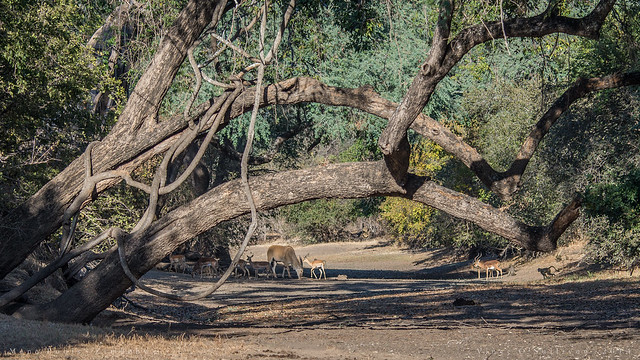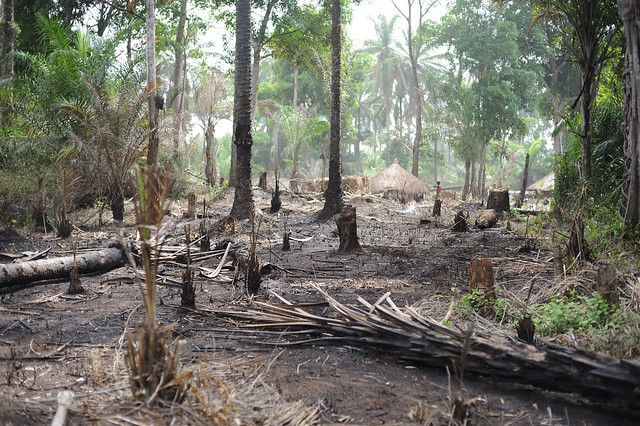聯合國糧農組織(FAO)在第14屆世界林業大會上發表報告指出,1990年起,全球損失近1億2900萬公頃的森林,約等於整個南非的面積,且因人口增加和林地開發,仍然持續萎縮當中,估計未來20年還會減少1億7000萬公頃的森林。
 |
| 辛巴威北部的自然保留區,野生動物正在乾涸的河床尋找水源。圖片來源:Vince O'Sullivan(CC BY-NC 2.0) |
砍伐熱點有11處 森林持續萎縮
根據FAO的「2015年全球森林資源評估」(The Global Forest Resources Assessment 2015)報告,1990年起,全球損失近1億2900萬公頃的森林;過去25年間全球森林砍伐速度已減緩超過50%,但是全球森林仍然持續萎縮。
世界自然基金會(WWF)森林計畫主任Rod Taylor也認為全球森林的前景不樂觀。
「WWF的分析顯示這個趨勢將持續,除非立即有積極的作為解決砍伐問題,未來森林的消失將集中在11個砍伐熱點,將有多達1億7000萬公頃——等於德國、法國、西班牙和葡萄牙面積總和——的森林會在20年內消失。」
2050年森林願景 肯定多樣性價值
召集來自142國的4000位代表參加、為期一周的世界森林大會於11日結束,與會代表發表《德班宣言》(Durban Declaration),型塑2050年的三點森林與林業願景。
宣言內容第一點,即肯定了森林不只是樹木的聚集地,更是糧食安全和改善生計的基礎。
宣言說明,未來的森林將透過提供糧食、木材能源、棲身之處、飼料和纖維賦予社群韌性;創造收入與工作機會讓社群繁榮;涵養生物多樣性;穩定土壤、支持永續農業和人類的福祉,並且調節水流。
第二點則主張整合性的土地利用,可改善森林政策和實務,因應森林砍伐的驅動因素;解決土地利用的衝突;計算整合森林與農業後的社經與環境利益;並保持森林繼續在原來的地景之下提供多樣化的服務。
第三點主張森林是氣候變遷調適與緩解的基礎。永續管理森林能增加生態系統與社會的韌性,充分利用森林與樹吸收和儲存碳,同時提供其他服務的能力。
實踐森林願景 原民、青年都要參與
德班宣言寫道,實踐這樣的願景需要森林、農業、金融、能源、水資源和其他產業部門建立新的合作關係,讓原住民與地方社群參與。
總幹事José Graziano da Silva表示,FAO的評估報告調查全球234國家與領地的森林管理現況,發現有越來越多森林受到保護,各國也開始改善森林管理政策,通常是透過立法、測量監控森林資源和當地社群參與規劃開發政策等方式達成。
此外,還需要森林教育、溝通、能力建構、氣候變遷對森林健康與疾病影響的相關研究,以及創造年輕人工作機會等方面的投資才能成功。
 |
| 在剛果民主共和國,原始部落焚燒森林以建造臨時的棲身處所。圖片來源:Julien Harneis(CC BY-SA 2.0) |
Over the past 25 years the rate of global deforestation has slowed by more than 50 percent, even though the world’s forests continue to shrink as populations increase and forested land is developed, the UN’s Food and Agriculture Organization, FAO, reports.
Some 129 million hectares of forest – an area almost equivalent in size to South Africa – have been lost since 1990, according to FAO’s most comprehensive forest review to date, “The Global Forest Resources Assessment 2015.”
 |
| 烏干達基巴萊國家公園(Kibale National Park),一隻猩猩獨坐在路旁。圖片來源:Kent MacElwee(CC BY-NC-ND 2.0) |
FAO Director-General José Graziano da Silva, launching the report in Durban at the 14th World Forestry Congress last week.
The FAO report confirms the huge loss of tropical forests over the last 25 years, and Rod Taylor, director, WWF Global Forest Programme, is warning that the future of forests is not bright.
“WWF’s analysis shows that this trend will continue with future losses concentrated in 11 ‘deforestation fronts,’ unless bold and urgent action is taken to address the drivers of deforestation,” said Taylor.
“Without such action, up to 170 million hectares – the size of Germany, France, Spain and Portugal combined – will be wiped out in just 20 years,” he warned.
The assessment, which investigated forest management in 234 countries and territories, found that forest areas have increasingly come under protection while more countries are improving forest management.
This is often done through legislation and includes the measuring and monitoring of forest resources and a greater involvement of local communities in planning and in developing policies.
Close to 4,000 delegates from 142 countries attended the congress, including representatives from civil society, intergovernmental and non-governmental organizations, universities and the private sector, as well as 30 ministers and deputy ministers.
After a week of debate, the largest gathering on forests this decade set forth its vision of how forests and forestry should look in 2050.
As the Congress closed on Friday, delegates issued the Durban Declaration – a 2050 vision for forests and forestry that makes three main points.
“Forests are more than trees and are fundamental for food security and improved livelihoods,” the document declares.
“The forests of the future will increase the resilience of communities by providing food, wood energy, shelter, fodder and fibre; generating income and employment to allow communities and societies to prosper; harbouring biodiversity; and supporting sustainable agriculture and human well being by stabilizing soils and climate and regulating water flows,” it states as its first major point.
And third, the declaration views forests as “an essential solution to climate change adaptation and mitigation.”Second, it declares that, “Integrated approaches to land use provide a way forward for improving policies and practices to: address the drivers of deforestation; address conflicts over land use; capitalize on the full range of economic, social and environmental benefits from integrating forests with agriculture; and maintain multiple forest services in the landscape context.”
“Sustainably managed forests will increase the resilience of ecosystems and societies and optimize the role of forests and trees in absorbing and storing carbon while also providing other environmental services,” the document states.
Realizing this vision will require new partnerships among the forest, agriculture, finance, energy, water and other sectors, and engagement with indigenous peoples and local communities, the Durban Declaration states.
Success will require further investment in forest education; communication; capacity building; research, including climate change impact on forest health and diseases; and the creation of jobs, especially for young people.
※ 全文及圖片詳見:ENS








